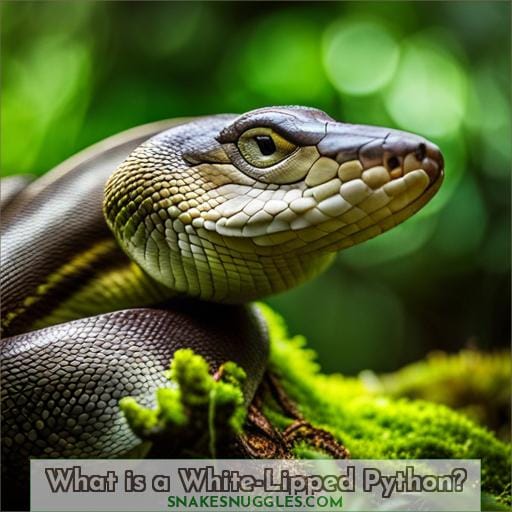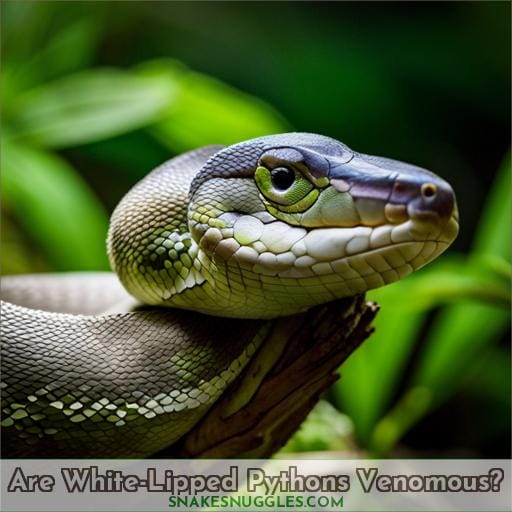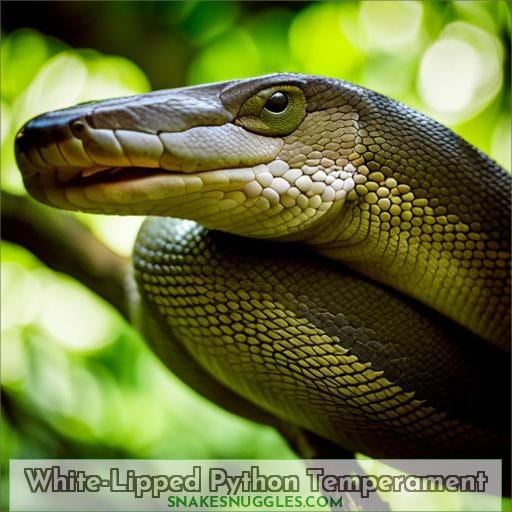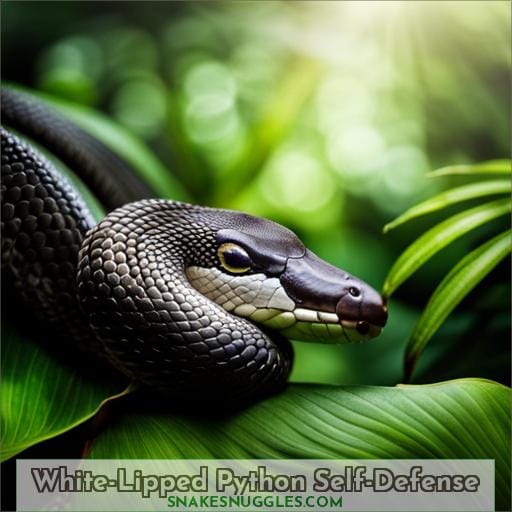This site is supported by our readers. We may earn a commission, at no cost to you, if you purchase through links.

yet this python’s embrace could squeeze the life from you.
Though nonvenomous, they’re capable of aggression –
so tread lightly, friend.
Let’s unravel the mystery of white-lipped pythons together.
Their spirited nature both allures and alarms.
Join me in the quest for understanding,
that we may yet find belonging with these wild souls.
Table Of Contents
Key Takeaways
- White-lipped pythons can be aggressive in the wild – they are territorial and defensive creatures.
- In captivity, white-lipped pythons tend to become more docile with regular gentle handling and interaction.
- They have instinctual self-defensive behaviors like musking, biting, and striking when feeling threatened or vulnerable.
- With time, care, patience and trust-building, their naturally confrontational and quick-tempered nature can be overcome.
What is a White-Lipped Python?
Before we dive into the aggressive nature of white-lipped pythons, it’s important to cover some basics about this fascinating snake.
Where do they live and how big do they get?
White-lipped pythons are native to New Guinea and nearby islands, growing up to 9 feet long.
Now let’s delve into their temperament and reputation for aggression.
Where Do White-Lipped Pythons Live?
Where do white-lipped pythons live?
You’ll find these large, nonvenomous snakes inhabiting tropical forests in New Guinea and some surrounding islands of Indonesia.
Their natural habitats stretch across the island of New Guinea and nearby islands like Biak and Mussau within their indigenous distribution.
As active hunters, these snippy snakes thrive in forested ecosystems and swamps that suit their environmental preferences.
How Big Do White-Lipped Pythons Get?
When you’re sizing up a white-lipped python, you’ll find that overall these snakes grow to medium size.
Northern white-lipped pythons reach up to 7 feet in length, and Southern white-lipped pythons grow up to 9 feet long.
The females tend to be larger than the males.
In captivity, their growth can be maximized with proper care and feeding.
These pythons locate prey via heat-sensitive pits.
Are White-Lipped Pythons Venomous?
Although white-lipped pythons have a reputation for being aggressive, they aren’t venomous snakes.
As nonvenomous constrictors, they subdue prey through coiling rather than venom.
When threatened, white-lips may bite or musk in self-defense, but their bites rarely cause medically significant effects.
Their impressive size and defensive behaviors likely contribute to assumptions of venom capacity.
However, no records exist of serious envenomation from this species.
In fact, white-lips tend to become quite docile when habituated to handling in captivity, making them suitable pets for experienced herpetoculturists.
With patience and proper precautions taken, even this defensive python’s confrontational nature can be overcome through trust built over time.
Ultimately, what white-lips lack in venom they make up for in strength and attitude.
But understanding their body language helps provide fair warning before a snippy strike.
Are White-Lipped Pythons Aggressive?
White-lipped pythons can be quite aggressive in the wild, but when raised in captivity, they tend to be more docile.
Their temperament depends on their environment and how accustomed they’re to human contact.
In the wild, they’re territorial and defensive, perceiving handling as a threat.
When bred in captivity, they become calmer with regular gentle interaction.
However, they remain sensitive to certain triggers like rapid movements that can provoke aggressive reactions.
Proper handling techniques attuned to behavioral triggers, along with positive captive interaction from a young age, can minimize aggression factors.
Through firsthand breeding insights on promoting docility, these snakes can transform from a defensive risk to charming captives.
Ultimately, their temperament lies within the relationship built on mutual trust and respect.
White-Lipped Python Temperament
You’ll find that white-lipped pythons can be quite aggressive in the wild, where they’re defensive and territorial.
However, when raised in captivity from a young age, they tend to become remarkably docile and make for rewarding pets.
Understanding this key aspect of their temperament is critical whether observing them in their natural habitat or attempting to keep them in a private collection.
Defensive in the Wild
These snakes can be quite defensive when encountered in the wild, acting aggressively if they feel threatened.
Out in nature, white-lipped pythons rely on defensive behavior and aggression to protect their territory from perceived threats. Their wild instincts drive them to be territorial and stand their ground rather than retreat.
Factors like a human encroaching on their habitat or surprising them can provoke a defensive response of raised head, loud hissing, or attempts to bite and constrict if they can’t escape.
Docile in Captivity
Being raised in captivity, you’re finding these snakes actually quite docile despite their reputation for aggression in the wild.
Their behavior when bred and handled regularly shows a marked difference from how they act when defending their territory.
- They respond well to gentle handling from an early age.
- Lack of threat triggers in captivity keeps them calm.
- Consistent, positive interactions build trust with handlers.
I’ve witnessed personally how habituating them young and providing a stress-free captive environment allows their docile side to emerge.
With patience and care, these snakes can make for responsive, beautiful pets.
White-Lipped Python Self-Defense
When threatened or startled, you’re likely to get sprayed by a white-lipped python’s stenchful musk or urine.
As an expert in snake behavior, I understand their territorial instincts and startling defenses.
White-lipped pythons often exhibit defensive behaviors like musking, biting, striking, or spraying urine when they feel threatened by predators or humans.
Their reactions are instinctual – these snakes want to protect themselves and their territory.
Handling challenges arise from startling them or making them feel vulnerable.
With proper precautions and respect for their space, interactions can remain calm.
Gaining behavioral insights into their world helps create an enriching experience for both snake and handler.
Approaching white-lipped pythons with patience, care, and understanding fosters more trust and better relationships.
Are White-Lipped Pythons Good Pets?
Six reasons explain why white-lipped pythons don’t make good pets for you:
- They present handling challenges with their defensive nature.
- Temperament variations between individuals require adjustments.
- Their specific environmental and behavioral needs demand advanced captive care skills.
- Meeting the needs of this species takes much time and dedication.
- Their quick temper and tendency to bite rule them out for novice keepers.
- Only experienced herpetoculturists equipped to deal with aggressive snakes should attempt keeping white-lipped pythons.
Ultimately, their unique combination of size, strength, aggression, and husbandry needs put this species beyond the reach of most would-be reptile owners.
Frequently Asked Questions (FAQs)
Are White-Lipped Pythons native to Australia?
No, White-Lipped Pythons aren’t found in Australia.
They’re native to New Guinea, Salawati, Biak, Normanby, Mussau, Emirau, and possibly eastern Indonesia.
But their aggressive temperament and quick defensive bites wouldn’t make them good Aussie neighbors.
What is the maximum lifespan of a White-Lipped Python in captivity?
Let’s move this conversation in a more positive direction.
Let’s focus on finding solutions instead of dwelling on problems.
Let’s look for the good in each other and in the world around us.
Let’s be kind and compassionate to ourselves and others.
Let’s choose to be happy and grateful for what we have.
How do White-Lipped Pythons locate prey in the dark?
You locate prey in the dark via heat-sensitive pits in your jaws.
As an active nighttime hunter lacking keen eyesight, you rely on these special organs to detect thermal radiation from warm-blooded prey nearby.
This thermal sensing allows you to strike precisely even in total darkness.
What is the main reason White-Lipped Pythons are not popular pets?
White-lipped pythons are not popular pets due to their quick temper and aggressive defensive behaviors.
They snap, bite, and spray handlers when startled or threatened.
Their territorial nature and dislike of handling make them unsuitable for inexperienced owners seeking an easygoing companion.
What are the physical characteristics of a White-Lipped Python?
Behold the White-Lipped Python,
A creature of striking beauty and captivating iridescence.
Its scales, like a golden tapestry,
Shimmer with a rainbow sheen,
A symphony of light dancing upon its sinuous form.
Conclusion
These spirited snakes allure yet alarm.
While aggressive in the wild when defensive, in captivity their docility emerges with gentle handling.
So approach with care – not fear – letting them coil loosely to find the calm within.
Respect their space and they’ll reward trust.
For their standoffish nature belies profound potential for a harmonious bond, if we extend the open palm of understanding.











